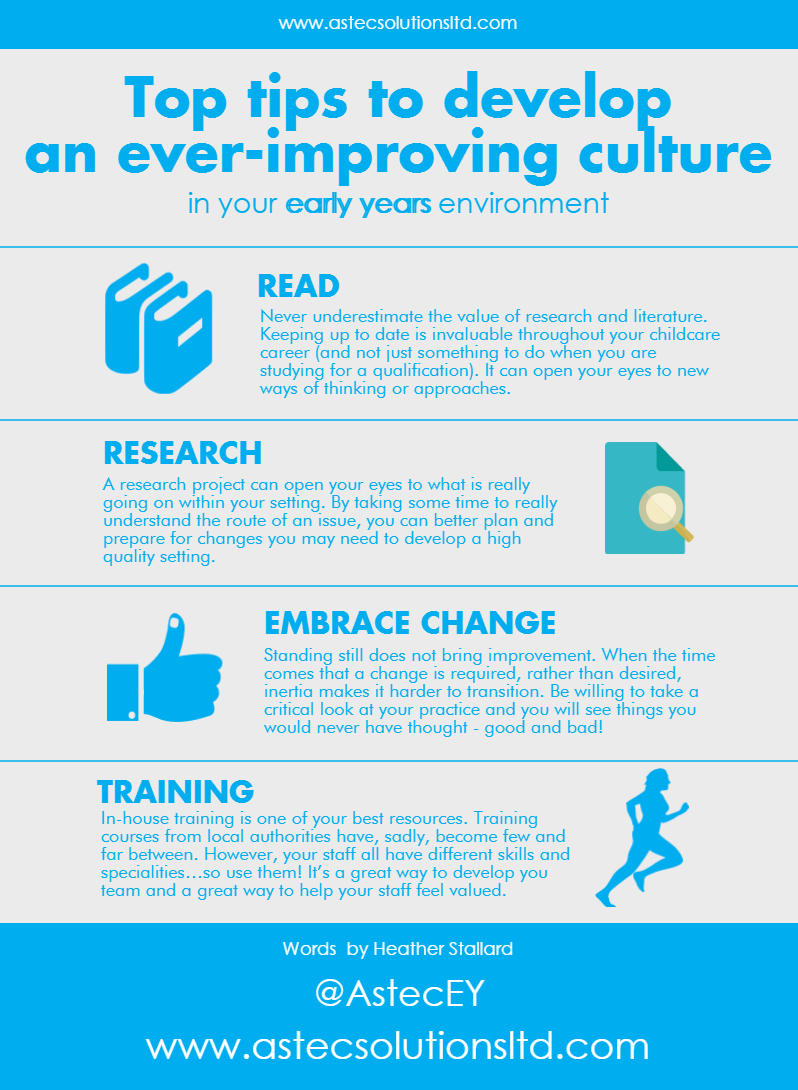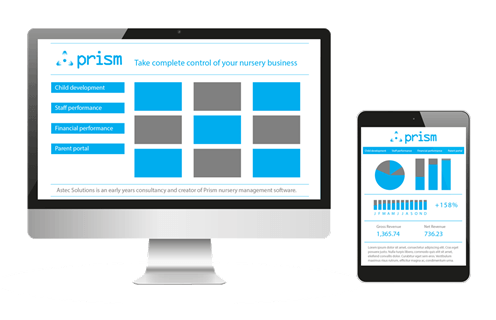I was scrolling through my favourite early years related hashtag, #EYTalking, when I stumbled across the question: what makes a good blog post?
I have a question for EY bloggers out there – what makes a good blog post? Length? Content? Tone? Any tips very welcome #thanks #EYTalking
— Emma (@EmmaDee77) January 7, 2016
The answer, you’ll be very disappointed to learn, is: it depends.
That’s not a good enough answer!
OK. Try this:
What constitutes a good blog post depends on your target audience and what you want to achieve.
This could be different for each and every one of you. For example:
- a consultant may want to provide reason for nursery owners and managers to consider him/her to be an expert in a particular field (wink, wink)
- a student may want to share their journey to EYT status to connect with and get support from peers.
Those are very different desired outcomes with very different audiences in mind. So, if you want a reader to do (or feel) something based on your blog post, you’re going to have to create some targeted and engaging content that appeals directly to them.
To do that, you’re going to have to get your thinking hat on. Don’t worry, I’m here to help.
- Plan
- Research
- Content considerations
- Tone of voice
- Make connections
- Measure (& experiment)
1. Plan
“Give me six hours to chop down a tree and I will spend the first four sharpening the axe.” ― Abraham Lincoln
 When you’re clear on the purpose of your blog and who you’re writing for you’ll find it much easier to craft a focused and effective piece.
When you’re clear on the purpose of your blog and who you’re writing for you’ll find it much easier to craft a focused and effective piece.
So, you need a plan.
Think about some of the things we’ve already discussed – your overall goals and your audience:
- why do you want to write a blog
- what messages do you want to get across
- what you want your audience to think feel and/or do.
You’ll also have to think about what your audience wants to read and how they will respond. To get to this point, you’ll probably need to carry out a bit of research…
2. Research
“Research is what I’m doing when I don’t know what I’m doing.” – Wernher von Braun
 I applaud you for taking the time to research the subject of high quality blog posts. It suggests that you’re the diligent sort of person who’ll also enjoy studying the way prominent bloggers (in any field) structure their posts. There’s a reason why some blogs are more popular than others, so see what you can learn!
I applaud you for taking the time to research the subject of high quality blog posts. It suggests that you’re the diligent sort of person who’ll also enjoy studying the way prominent bloggers (in any field) structure their posts. There’s a reason why some blogs are more popular than others, so see what you can learn!
You should also identify some examples of content that appeal to your audience. You can:
- ask your prospective audience what authors they like to read, what websites they visit and what subjects they’d like to know more about
- use your favourite search engine to find popular articles and blog posts related to your chosen subject
- find influencers who write or share content on your chosen subject
Once you’ve found your inspiration and built a bank of ideas, you can confidently begin to craft your masterpiece.
Pro tip
Twitter is a great resource for finding interesting content about childcare. There is a very active early years contingent to connect with and you can find them by searching relevant hashtags, such as: #EYTalking, #earlyyears, #childcarehour or #eyfstwitterpals.
3. Content
“Nothing listens as well as a blank page.” ― Shaun Hick
 A blank page (screen!) is brimming with potential, waiting for you to add something beautiful and amazing. You might not be able to write the nation’s favourite children’s poem, but if you take into account the following few points, at the very least, you won’t disappoint.
A blank page (screen!) is brimming with potential, waiting for you to add something beautiful and amazing. You might not be able to write the nation’s favourite children’s poem, but if you take into account the following few points, at the very least, you won’t disappoint.
a. Length
They say that size does matter.
Please now take your mind out of the gutter!
The common maxim is that a post should be about 400-1000 words. This is a useful guide (for reasons I won’t go into here). However, I tend to think that:
great content can come in all shapes and sizes.
Seth Godin is a prominent marketer and speaker whose blog is incredibly popular. His posts are thoughtful and insightful and tend to be much less than 400 words.
On the flipside, there are some excellent examples of “longform” posts that are well over 1000 words. These are very different types of content (eg. not a blog), but no less appreciated by their audience:
A lot of time has been spent on each of the examples above and it shows. You do not have to throw away words that have merit just to meet a word count, but – if you’re “going long” – make sure that you give your content the time and effort it needs to keep your audience engaged.
Gap in the market for longform early years journalism?
The “longform” post above on day care in the USA is the best I could find related to childcare. Who fancies producing some quality investigative journalism or a detailed research report? Come on Nursery World or Ceeda!
@AstecEY @EYTalking @RikDuddy errm.. Keep it simple.. Less than 500 words (folks are time poor) and speak from the heart.. 1/2
— Laura Henry (@LauraChildcare) January 29, 2016
b. Be creative
An image can be powerful.
Add a few words to an image and it could become more powerful.

You can even add a few words to several images to create something even more powerful.
OK, so the infographic is not as powerful as the Martin Luther King image/quote combo, but it was shared far and wide amongst the early years contingent. It even ended up as a poster on the walls of a couple of nurseries!
Don’t be afraid to use photos, infographics or videos (and anything else you can thing of) if they add something to your post. Use whatever method best gets your message across. Such as this magnificent animation from some company that sells nursery management software…
c. Get your message across
 The quality of your content is paramount, but there’s more at play than just your words.
The quality of your content is paramount, but there’s more at play than just your words.
The overall look and feel of your page/website is also important.
Fortunately, you don’t have to spend a fortune on a designer. There are a few simple things you can do to make sure your blog communicates your key messages clearly.
The theory goes that people read differently on the web. Readers tend to scan a page and that means you can employ a few cues to draw attention to your key points. Such as:
- bullet points
- headings and subheadings
- images etc
- bold/emphasis to make your key points stand out.
Keep these tips in mind whether you’re blogging on your own website or using the blog capabilities native to platforms such as LinkedIn.
4. Tone of voice
“We often refuse to accept an idea merely because the tone of voice in which it has been expressed is unsympathetic to us.” – Friedrich Nietzsche
 Childcare is a serious business with lots of serious subjects to talk about. That doesn’t mean your blog has to be serious in tone. (Alternatively, childcare can be hilarious but that doesn’t mean readers will appreciate frivolity).
Childcare is a serious business with lots of serious subjects to talk about. That doesn’t mean your blog has to be serious in tone. (Alternatively, childcare can be hilarious but that doesn’t mean readers will appreciate frivolity).
The truth is, different people will have different responses to different styles of communication. It’s therefore important to think about who you are writing for and the perceptions you want people to have of you (particularly if you’re representing a business). Having said that, a blog is by its nature something quite personal, so it’s fair for your readership to expect some consistency with you as a person. You need to find an appropriate balance.
Read David Wright’s blog post on an OFSTED inspection at one of his settings. David – aka Mr Paint Pots – does a great job of communicating the emotional turmoil he’s going through. It’s not a scholarly piece for research fellows, but an explanation of a personal experience that really shows parents/prospective parents and colleagues how much David’s cares. Importantly it’s consistent with David as a person and the philosophy of his business.
Think about who you’re writing for, what you’re writing about and who you are representing.
5. Connect
“If a tree falls in a forest and no one is around to hear it, does it make a sound?” – anon
 You could write the highest quality post with the most beautiful words and appropriate images, but it won’t be much use if nobody knows it exists.
You could write the highest quality post with the most beautiful words and appropriate images, but it won’t be much use if nobody knows it exists.
So, there are two things you have to do:
- Let people know your content exists.
- Make it easy for people to find your content.
1. Let people know your content exists
The simplest way to do that is to connect with people. Tell your friend and colleagues and contacts in the face, via email, carrier pigeon or other.
You can also find and engage with key influencers on social platforms, such as twitter and LinkedIn. Once you’ve established a relationship by joining in conversation and by sharing other useful content, your new contacts will be more than happy to read and promote yours.
2. Make it easy for people to find.
You can help search engines (such as google) find your content by including a few important key words in your content.
- Let’s say your prospective reader is interested in EYFS observations.
- When your prospective reader types the words “EYFS observations” into a search engine, it scours the internet for content that is relevant to those words.
- So, include the words “EYFS observations” naturally in your content – say, once in the title and in body text – to make it easy for google to find.
The business of making your content easy to find (Search Engine Optimisation) is a reasonably complicated subject. If there’s demand I may write some more about it. Otherwise, read this basic guide or give me a call.
Pro Tip
If you quote someone in your content or link to their website, let them know that you have done so as a courtesy. It’s nice to do so, but it also means they are likely to share or link to your content…making it even easier for people to find!
6. Measure & experiment
“The proof is in the pudding.” – Anon
 An advantage of communicating your content by digital media is that you can easily analyse how well your content has performed.
An advantage of communicating your content by digital media is that you can easily analyse how well your content has performed.
It’s relatively easy for you to access useful data in many common programmes, such as:
- traffic to your website (google analytics)
- how many people have “liked” your content (twitter / facebook)
- how often your content has been shared. (twitter / facebook / hootsuite etc)
You can also use data to look forwards. The more posts you write, the more data you’ll collect and the more insight you’ll have to inform your future content.
Try writing different types of posts and in different styles and see what helps you achieve your objectives. You could, for example, alter some of the things we discussed earlier, such as:
- length
- tone of voice
- design/format: with image, without images etc
- topic
- …a combination of those and more.
See how each variable impacts your results and find out what gets you the best results. In fact, that’s not a bad answer for the original question:
Q. What makes a good blog post?
A. One that works
If you want some help planning or writing your next blog post – or even getting started with your website – please leave a question in the comments section or give me a call 020 8655 7888.
Richard Duddy
Latest posts by Richard Duddy (see all)
- Officrèche found its voice (and slapped me right in the face) - 17 May 2016
- What makes a good blog post? - 28 January 2016
- Choosing nursery management software: how to select an effective solution - 24 August 2015





Recent Comments